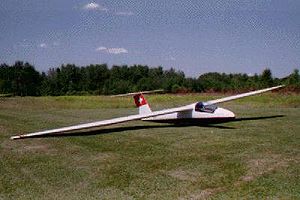Pilatus PC-11
| Pilatus PC-11 / B4 | |
|---|---|

|
|
| Type: | Glider |
| Design country: | |
| Manufacturer: | |
| First flight: |
May 5th 1972 |
| Production time: |
until June 1978 |
| Number of pieces: |
332 |
The Pilatus PC-11 (also Pilatus B4 ) is a single-seat all-metal glider from the aircraft manufacturer Pilatus Aircraft .
history
Development of the B4 began in the 1960s at Rheintalwerke G. Basten (designers: Manfred Küppers, Ingo Herbst and Rudolf Reinke), which also produced two prototypes (first flight V1 D-7201 on November 7, 1966). The V1 and V2 had a fixed main wheel. The wings were connected separately to a spar bridge in the fuselage. The bast B4, which was not approved for aerobatics, was not produced in series.
In 1972 Pilatus bought the license, modified the design (the wing spars were now connected directly to one another) and started series production under the designation PC-11. The first aircraft of this type made its maiden flight on May 5, 1972 and received the registration HB-1100. Only a few glider pilots know the official designation PC-11, the aircraft is generally known under the name B4. The B stands for the original developer Basten.
The B4 is a standard class glider and was a popular group airplane due to its all-round characteristics (comfortable flight behavior and approved for both aerobatics and cloud flying) and its robustness. However, their gliding performance no longer corresponds to today's expectations, especially in the high-speed range. For a long time it was also used in aerobatic competitions for advanced classes. Occasionally you can still find them in the advanced class, more often in the sportsman class. In 2010 the Swede Johan Gustafsson became world champion in the Advanced with the B4-PC11AF.
The original PC-11 was only approved for "simple" aerobatics (i.e. only for positive figures). With the further developed PC-11A, negative figures such as inverted flight, rolling and forward looping were also possible. At the same time, the PC-11AF version with a reinforced fuselage tube was approved, with which also cracked figures and thus unrestricted aerobatics were permitted. There was a program with which B4s that had already been built could be retrofitted to the A version and this to the AF version. The disadvantage for aerobatics is the very low maximum speed of 240 km / h and the correspondingly low maneuvering speed, as well as the low rolling maneuverability compared to other single-seaters.
production
By the time the production rights were sold to the Japanese company NIPPI in June 1978, 322 gliders of this type had been delivered worldwide. Nippi built 13 copies. Based on the B4, Nippi also developed a two-seater, which made its maiden flight in 1983, but never went into series production.
Technical specifications
| Parameter | B4-PC11 | B4-PC11A and B4-PC11AF |
|---|---|---|
| Years of construction | 1972-1988 | |
| Manufacturer | Pilatus Aircraft | |
| constructor | M. Küppers, I. Herbst and R. Reinke | |
| crew | 1 | |
| span | 15 m | |
| length | 6.57 m | |
| height | 1.57 m | |
| Wing area | 14.05 m² | |
| Elongation | 16 | |
| Glide ratio | 35 at 85 km / h | |
| Slightest sinking | 0.64 m / s at 75 km / h | |
| Empty mass | 230 kg | |
| payload | 120 kg | |
| Max. Takeoff mass | 350 kg | |
| Top speed | 240 km / h | |
| Maneuver speed | 145 km / h | 163 km / h |
| Stall speed | approx. 61 km / h | |
| Max. Load multiple | + 6.3 / -4.3 | + 7 / -4.7 |
| profile | NACA 64 3 -618 | |
accident
On June 23, 2018, 3:45 p.m., a pilot with a PC-11 at the Mauterndorf glider airfield , Land Salzburg, had a fatal winch launch from a height of around 20 m.
Web links
- Information from SAGA about the B4
- The B4 / PC-11 flies to a World Championship title!
- Device identification sheet